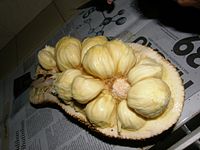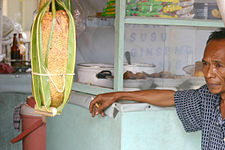Artocarpus integer
| Artocarpus integer | |
|---|---|

| |
| Scientific classification | |
| Kingdom: | Plantae |
| Clade: | Tracheophytes |
| Clade: | Angiosperms |
| Clade: | Eudicots |
| Clade: | Rosids |
| Order: | Rosales |
| Family: | Moraceae |
| Genus: | Artocarpus |
| Species: | A. integer
|
| Binomial name | |
| Artocarpus integer | |
| Synonyms | |
| |
Artocarpus integer, commonly known as chempedak or cempedak (also known as baroh [Malaysia/Indonesia], tibadak in Brunei, sonekadat [Burma], thampada [thailand], jack tree [English], hathar [Hindi], comedak [Java], chakka [Tamil], and mit to nu [Vietnamese]) is a species of tree in the family Moraceae, and in the same genus as breadfruit and jackfruit. It is native to southeast Asia. Cempedak is an important crop in Malaysia and is also popularly cultivated in southern Thailand and parts of Indonesia, and has the potential to be utilized in other areas. [1]
Description
Cempedak trees are large, evergreen trees. They can grow to a height of 20 m, although most only reach a dozen meters. The trees are monoecious, with male and female flowers growing on the same tree. There are many varieties, although few are named. The vigorously growing tree can bear heavy crops of fruit once or twice a year.
Fruit
The syncarp may be cylindrical to spherical in shape, and ranges from 10 to 15 cm across and 20 to 35 cm in length.[2] The thin and leathery skin is greenish, yellowish to brownish in color, and patterned with pentagons that are either raised protuberances or flat eye facets.
The fleshy, edible arils surround the large seeds in a thick layer. These arils are edible by boiling or roasting. Arils are yellowish-white to orange in color, sweet and fragrant, soft, slippery and slimy on the tongue and a bit fibrous. The taste of the fruit is similar to the related jackfruit and breadfruit with a hint of durian. The seeds are flattened spheres or elongated, about 2–3 cm in length.
Cempedak is similar to jackfruit in many ways, however, cempedak are smaller than jackfruit and the peduncle is thinner. The male inflorescence of cempedak is pale green to yellow compared to the dark green of jackfruit. The cempedak flesh is darker yellow and more juicy when ripe.[3]
Cultivation
Cempedak trees are normally planted in un-eroded and well-drained soils, although they can tolerate temporary flooding. Cempedak can be grown between 0 and 1200 m altitude from sea level at temperatures between 13 and 47 °C and with annual rainfall of 1250 2500 mm. Trees begin to bear fruit at 3-6 years for trees planted by seed and at 2-4 years for clonal trees. Blossoms are common from February to April and then again in August to October in southern Malaysia, as opposed to in western Java, where Cempedak tend to flower in July and August. From flowering to ripening fruit takes about 2-4 months.[3]
Uses
The fruit is consumed in its native area, can be eaten fresh or cooked. The seeds can be fried, boiled or grilled, then peeled and eaten with salt. The taste is similar to water chestnuts. The young fruit, like young jackfruit, can be used as a vegetable.[2] In Borneo, the skin of the cempedak can be processed into food called mandai made by peeling the fruit until it looks white, then soaking it in brine to preserve and soften the texture. Mandai is usually consumed after frying.[2]
The wood is of good quality, strong and durable, and used as building material for home furnishings or boats. The fibrous bark can be used to make ropes. Yellow dye can also be produced from the wood.[2]
Gallery
See also
References
- ^ a b Wang, M.M.; Gardner, E.M.; Chung, R.C.; Chew, M.Y.; Milan, A.R.; Pereira, J. T.; Zerega, N.J. "Origin and diversity of an underutilized fruit tree crop, cempedak (Artocarpus integer, Moraceae)". American Journal of Botany. 105(5): 898-914. doi:10.1002/ajb2.1094.
- ^ a b c d Jansen, P.C.M. 1997. Artocarpus integer (Thunb.) Merr. dalam Verheij, E.W.M. dan R.E. Coronel (eds.). Sumber Daya Nabati Asia Tenggara 2: Buah-buahan yang dapat dimakan. PROSEA – Gramedia. Jakarta. ISBN 978-979-511-672-1.
- ^ a b c Paul, Robert; Duarte, Odio. Tropical fruits (2nd ed.). CABI. ISBN 1845937899.
External links
For more information, see "Fruits of the Future: Chempedak" by David K. Chandlee [1]










